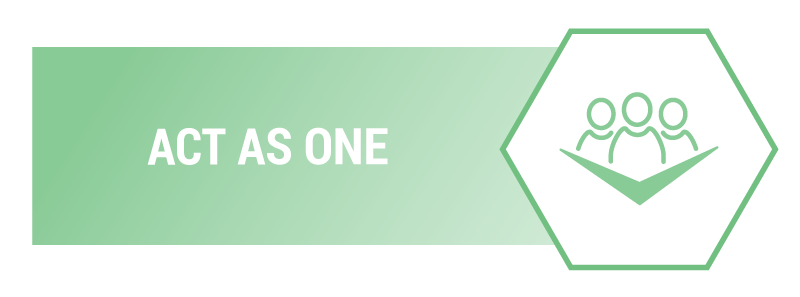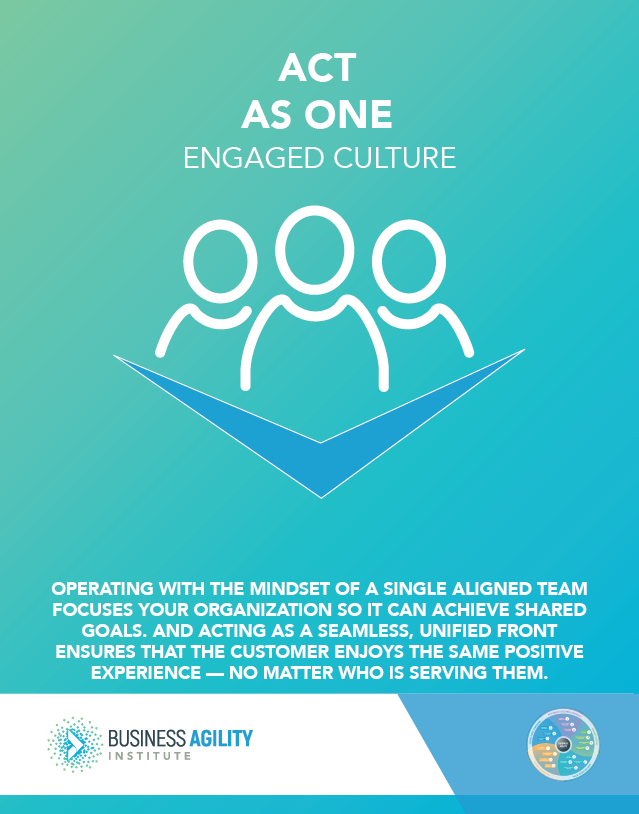Domains of Business Agility
- Responsive Customer-Centricity
- / Fiercely Champion The Customer
- / Sense & Respond Proactively
- / Integrate Diverse Ideas
- Engaged Culture
- / Cultivate A “Learning Organization”
- / Engage Transparently & Courageously
- / Embed Psychological Safety
- / Act As One
- Value-Based Delivery
- / Unleash Workflow Creatively
- / Prioritize. Prioritize. Prioritize.
- / Deliver Value Sooner
- / Seize Emergent Opportunities
- Flexible Operations
- / Adapt Strategies Seamlessly
- / Fund Work Dynamically
- / (Re)Organize Structures Fluidly
- / Balance Governance And Risk
- People-First Leadership
- / Foster Authentic Relationships
- / Empower With Accountability
- / Realize People’s Potential
An agile organization is one that is designed to collaborate. Operating with the mindset of a single aligned team focuses your organization so it can achieve shared goals that span teams, functions, and divisions. Rather than locally optimizing a part of your organization, it’s critical to take a bigger perspective that encompasses how the whole system operates. Acting as a seamless, unified front ensures that the customer enjoys the same positive experience — no matter who within the organization is serving them.
Rather than taking a monolithic approach (imagine a single huge aircraft carrier), an agile organization with an aligned mindset embraces the autonomy of a flotilla of small boats sailing in concert to reach their collective destination. The very construct of the organization — from its organizational structure and work processes to its market engagement and external partnerships — promotes a sense of the organization being one team.
Primary Behaviors
The following 6 behaviors strongly contribute to the ability to act as one.
B30: Leaders invest time to communicate and align everyone in the organization around the strategic priorities, starting with the “why”: Leaders make sure that everyone in the organization understands what’s “most important” in support of the organization’s strategic priorities. Leaders take the time to make sure that everyone (at all levels) is aligned on the priorities and understands the motivation or “why” that is driving these priorities.
B31: Everyone does what it takes to achieve customer outcomes without being bound by job descriptions: When an opportunity is identified that will support desired customer outcomes, everyone is able to act on that opportunity. “Not my job” and “Not in my job description” are not excuses for ignoring such an opportunity.
B32: Leaders act in the interest of the organization rather than their own area: In other words, to design systems & structures to ensure that leaders operate as one team with unity of purpose towards the target customer experience.
B33: Everyone seamlessly and transparently integrates external partners into the value stream to achieve common goals: External partners (outside the company or organization) are treated as members of the team, and are included in the workflow just like the organization’s employees. The approach is one of shared responsibility and collaboration working together to achieve common goals (us together, rather than us versus them). Places in the process where external partners need to be treated differently are seen as exceptions to be minimized, rather than the standard approach for working together.
B34: Everyone invests in building trusted relationships with external partners to align them to the organization mission, strategy, and values: Getting complete business outcomes into the hands of customers today often requires collaborating with external partners to coordinate value creation and/or delivery. Everyone in the organization sees external partners as essential members of the team. Commensurate time is spent laying the foundation of productive long term relationships by aligning on mission, strategy and values, rather than approaching the work as purely transactional.
B35: Everyone in supporting functions (e.g. Finance, HR, or Audit teams) see their role as a partner (vs police) to business teams: Employees in functions that set policies and manage compliance activities for the organization see themselves (and are seen) as collaborators and supporters of the business teams, rather than bureaucratic enforcers of “the rules.”


